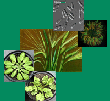| Senser, M; Beck, E: Kälteresistenz der Fichte, Berichte der Deutschen Botanischen Gesellschaft, 92, 243-259 (1979), doi:10.1111/j.1438-8677.1979.tb03275.x | |
| Abstract: Frost Hardiness in Spruce II. Influence of Photoperiod and Temperature on the Structure and the Photochemical Reactions of Spruce Chloroplasts Spruce chloroplasts are characterized by an annual cycle of seasonal changes in structure and function so that spring, summer and winter chloroplasts can be distinguished from one another. Spring chloroplasts present in the old needles during the period of bud sprouting resemble amyloplasts and provide reserve material for the young needle generation. After the completion of the development of the young shoots these plastids are converted into summer chloroplasts, the typical photosynthetic organelles exhibiting a compact membrane system. During frost hardening and especially during the frost period the chloroplasts then assume their winter form: they swell, become amoeboid and their membrane system is disorganized and reduced. These seasonally different chloroplast structures can — in the same way as frost resistance — be induced by the exogenous factors photoperiod and temperature. They are also accompanied by changes in the ability of the needles to assimilate C02, which is again accompanied by changes in the photochemical activities of the chloroplasts. Freezing experiments revealed that the frost hardening process depends on at least two processes: (i) stabilization of the photosynthetic membranes by protecting substances and (ii) by an alteration of the chemical composition of these membranes. At least the latter appears to cause a reduction of the photosynthetic ability. These experiments showed further that frost damage of spruce chloroplasts, occurring when the needles are not resistant, cannot be due to a direct influence of subfreezing temperatures, but must be due to a direct attack of membrane-toxic substances which are liberated from more labile cell compartments upon freezing. |

